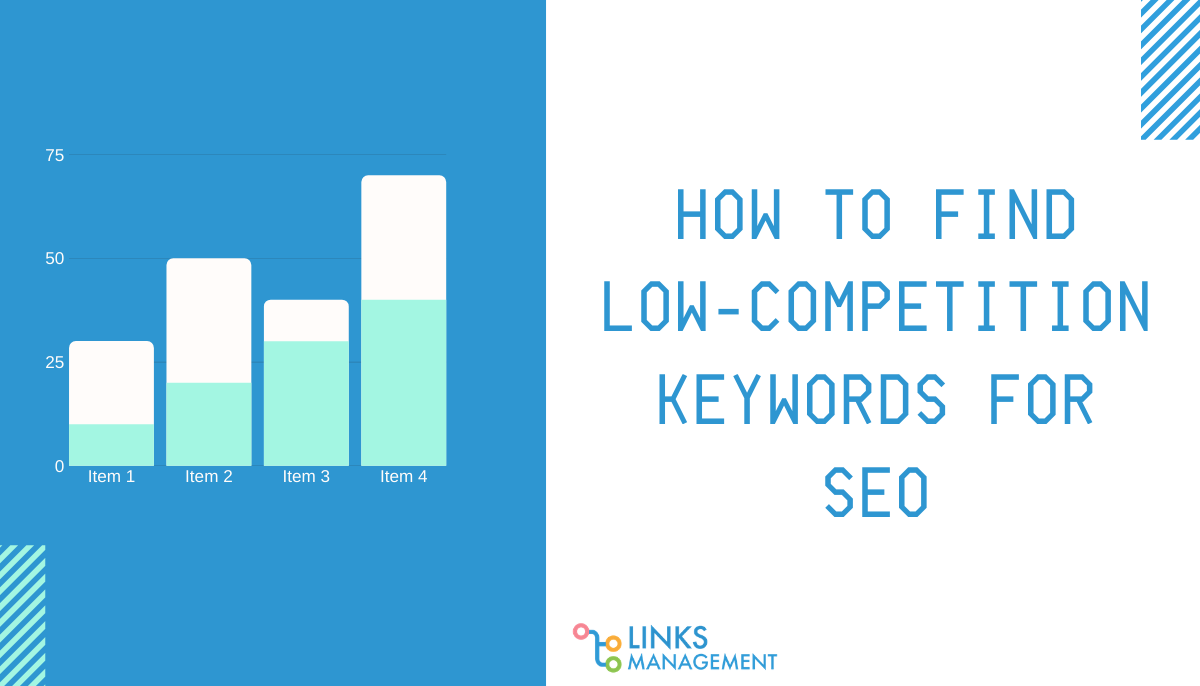How to Find Low-Competition Keywords for SEO
When working with a website in 2021, the first step is to find out its position in the Google search results. Then, it is vital to determine the resource’s strengths and weaknesses and draw up an optimization plan.

If you are promoting your own website or working as an SEO specialist in a company, information about positions in the results will be necessary for a clear idea of how users find a resource. It will also form the basis for further analytics. So let’s start SEO keyword research for the low competitive queries.
Why Is It Important to Track Website Visibility for Keywords
Before diving into the details, let’s take a look at a few important reasons why ranking data for the site you are promoting and competitors’ sites are essential for successful optimization.
Understanding the reasons for changing traffic. There are many factors that can affect the amount of organic traffic on the websites, and ranking is the best way to figure out which pages and keywords are effective, which ones are problematic, and why.
Identification of missed opportunities. Google is constantly improving its algorithms, focusing on user factors, and it becomes more difficult to track innovations. At the same time, each change in ranking is a new opportunity to take a step forward and overtake the competition.
Competitor monitoring. In addition to analyzing the visibility of search queries for your site, you can find out what positions are occupied by competitors and what target keywords they do not have. By position jumps, you can track what competitors were doing for their pages and keywords, and take the best methods into service. You can conduct niche keyword research. If you identify effective keys that work for other sites in your niche but you do not have, you can use them and, as a result, take some of the traffic for yourself.
Use of relevant keywords. If you know which keywords a particular page is displayed for, you can remove ineffective words and phrases. In the future, they can be used to create new content blocks that are relevant to the interests of users. It will also avoid keyword cannibalization where two or more pages on a site compete for the same query, confusing search engines. If another page is displayed for a certain key, it may be worth reconsidering the request intent – what is the user’s true intent, and how this page responds to them.
Getting data for the report. If an SEO specialist needs to prove the effectiveness of optimization methods, one of the ways is to provide data on the number of keywords for which the site is displayed in Google, on which positions it occupies and how much traffic it brings. This information also helps to track the dynamics of keywords over time.
Information about keywords close to the TOP-10. Keyword research makes it possible to determine popular pages that remain a little higher in the search results in order to reach the leading positions – work with meta tags, add links, fix usability problems, etc. This will allow you to achieve good results quickly.
Development of a promotion strategy. After identifying all the keywords for which the site is displayed, you can start developing an optimization plan to improve visibility in search: remove all ineffective keywords, create content that meets the interests of users, apply the semantics of competitors, and use other promotion methods for greater efficiency
The Value of Low-Competition Keywords in SEO
The golden rule of SEO is to search for keywords with a high volume of queries per month and at the same time with a relatively low level of competition. After all, what could be better than an influx of large amounts of targeted traffic? Typically, these keywords are a priority, and the entire strategy is built around them. However, this approach inevitably misses other opportunities. In particular, keywords with low traffic volume are almost never used.

Keywords with a small volume of queries per month (up to 250) are almost always ignored as unpromising. But is it worth ignoring them completely? And what benefit can you get if you still include keywords with a low volume of queries in your promotion strategy?
To begin with, it is worth looking at the situation in narrow niches. As a rule, finding keywords and phrases with a high volume of searches per month in such niches is quite tricky, if not impossible. Most of the keywords have an extremely low volume of queries – about 20 per month. Does this mean that such keywords should be discarded? Definitely not. Despite the fact that there is little traffic in narrow niches, it fully pays off.
It makes you think. What prevents them from paying off in other situations and other niches? In reality – nothing. Keywords that are rarely searched for in search engines often have high relevance and importance. At the same time, competitors are unlikely to use such keywords and phrases since they are considered “unpromising.” As a result, there is every chance, with a little effort, to ensure a good ranking for a number of keywords and phrases.
While this tactic may not be able to bring tens of thousands of customers and customers every month, the whole point here is how profitable it is. Promotion for keywords with a low volume of queries per month requires less effort, time, and money. The benefit will mainly depend on the average check.
If it’s profitable, why not take the opportunity to target keywords that are super-relevant to your target audience, even with a small amount of traffic?
The rule here is that quality is more important than quantity.
After all, you can always attract irrelevant traffic, but if visitors do not become buyers, then this approach will be completely meaningless. On the other hand, attracting even a small number of interested visitors always gives positive results.
If you ignore the opportunity to promote for keywords with low search volume, you may be missing out on valuable traffic – people who are already ready to convert. Moreover, competitors can always take advantage of this opportunity, and in the future, they will only have to regret this decision.
How to Evaluate the Prospect of a Keyword or Phrase
Of course, not all low-competition keywords are worth looking at. For example, let’s say that the average bill in an online store is 500 dollars. A keyword or phrase generates about 100 queries per month. To rank for this keyword in search engines, you need to spend 5000 dollars (mainly on content). As a result, if the attracted traffic in this situation leads to conversions in 2% of cases, it will take approximately 3 months to payback.
This may not be the best option, so it is worth looking for other keywords and phrases that are more promising. But again, one should not forget about such a variable as the average bill. If the average bill in an online store is 5000 dollars, then the return on investment can be seen after the very first conversion.
According to this principle, you should reasonably assess the prospects of certain keywords, taking into account costs, conversion rates, and average bills.
However, sometimes you can just come to terms with the fact that investing in content and promotion is a long-term investment that may not pay off soon. But in the future, all investments will not only return but also be able to make a profit.
Key Benefits of Low Traffic Keywords
High relevance. Typically, these are keywords that are super-relevant to the target audience. And this automatically affects the conversion. The more relevant your keywords are, the more sales there will be.
High profitability. Keywords with a small amount of traffic are promoted more easily. There is less investment, and the return on investment can be extremely high.
Low competition. Since the majority of optimizers ignore keywords and phrases with low search volume, the competition is not so high here either.
How to Do Keyword Research? The Best Services to Help You Find Keywords.
Once you are familiar with the concept of keywords, you can move on to collecting a complete semantic core for your site. Thanks to a properly selected semantic core, you can accurately describe and characterize the activities of your site, the goods, and services that you offer. Low-competitiveness of requests must be determined by a number of methods:
- the number of sites in the search results with the exact wording of the request;
- the number of sites in the top with the exact entry of the key into the title;
- the number of backlinks from unique domains with an exact or diluted key in the anchor;
- cost per click in contextual advertising

SEO experts recommend using the following services for the selection of keywords and the formation of the semantic core:
Google Keyword Planner. A free service from the Google search engine that helps in the selection of keys, the search for unique phrases to expand the semantics.
Multifunctional service for SEO specialists contains tools for collecting keywords from TOP-20 searches and forming a wide semantic core. Search suggestions and additional queries are available, as well as analysis of the semantics of competitors and viewing data on the frequency of use. Work with the service is paid. It is possible to use the free version with limited functions.
>SEMrush. The service, in its multifunctionality, is similar to Serpstat and is also paid for full use. In SEMrush, you can find unique features that are not found in other services designed to collect the semantic core, analyze strategies and promote sites.
SpyWords. The service allows you to compose a semantic core based on the resources of competitors. You can not only create a semantic cire from scratch but also supplement and expand. Information on the effectiveness of keys for business is also available.
KeywordTool. With the help of this service, you can collect semantic core not only from search phrases but also from popular queries from other platforms: YouTube, App Store, Amazon, eBay. Suitable for working with sites that are focused on Europe and the United States. Most of the tools are paid, but a free version with limited functionality is also available.
Ahrefs. Its module “Keywords explorer” will not give a 100% picture since to determine the key competitiveness, Ahrefs uses data from its own database, which is updated less frequently than Google’s and is much more modest in size. And the analysis method itself may seem rather primitive: Ahrefs takes the arithmetic average of the number of unique domains linking to pages from the top 10 for a given key, within the specified geo. But today, this method seems to be the most effective in its balance of productivity and time.
There are many more services that differ in cost, set of tools, and additional features. Each specialist chooses exactly the program that suits his needs and the specifics of a particular project.
Conclusion
Searching for keywords and phrases with a small volume of queries per month is not always a waste of time and money. Before completely ignoring them, it makes sense to figure out if there are opportunities. By adequately assessing costs and potential profits, you can find thousands of promising keywords and phrases that will not only pay off but also have every chance of bringing unexpectedly high revenue.
Enter URL & See What We Can Do Submit the form to get a detailed report, based on the comprehensive seo analysis.